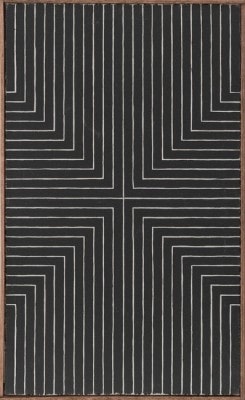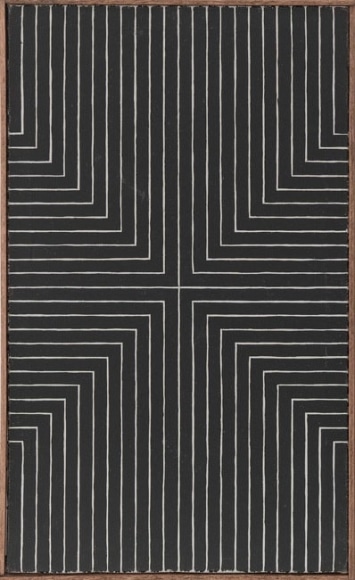Richard Pettibone

Stella, Die Fahne Hoch, 1959, circa 1965
Richard Pettibone (born 1938)
Creating small ‘pocket size’ paintings from Pop-Art images already made famous, Richard Pettibone does artwork that is described as “cloning”, which has resulted in “art that he can call his own.” (Smith) His copies include work by Andy Warhol and Jasper Johns as well as Marcel Duchamp and Roy Lichtenstein. It is done under the umbrella of ‘Dada’ and “he has seemed completely unperturbed by this apparent lack of originality.” (Smith) In July, 2005, an exhibition of work by Pettibone was held at the Philadelphia Institute of Art, and included were 215 works representing four decades of his career.
In her review of this exhibition for the New York Times, Roberta Smith wrote: “The walls are dotted (literally) with tiny versions of Warhol’s soup cans, Marilyns, cows and flowers, the latter sometimes multiplied into miniature wallpaperlike patches. There are shaped paintings locked together like puzzle pieces made from dovetailed versions of Lichtensteins, Warhols and, of course, Frank Stella’s early shaped paintings. A triple stack of diminishing Warhol soup cans mimics Jasper Johns’s Three Flags. More recent works include tiny copies of Mr. Stella’s vaunted black paintings, Duchamp’s Nude Descending a Staircase and baby Mondrians whose slightly blurred scaffoldings are intended to recreate the Dutch master’s famed optical buzz.
Underlying Richard Pettibone’s creations are his commitment to asking difficult questions such as ‘Who owns artistic ideas? What is originality? Why does art have to be large in size? What happens when paintings originally done in large size are reduced to small size?
Born in Los Angeles, Pettibone studied at Pasadena City College and the Otis Art Institute, where he earned an MFA in 1962. In 1964, when he was still in Los Angeles, he did his first copies of work by Andy Warhol, Campbell Soup Cans. The next year, he copied work by Ed Ruscha, Roy Lichtenstein, Jasper Johns and Frank Stella. His mediums are oil on canvas, wood, and silkscreen on canvas.
In 1988, he received a grant from the National Endowment for the Humanities.
Sources include:
Roberta Smith, “Imitations That Transcend Flattery”, The New York Times, July 15, 2005
Who’s Who in American Art, 20th Edition, 1993-1994
Edward Leffingwell, Art in America, November 2003
Biography from the Archives of AskART
